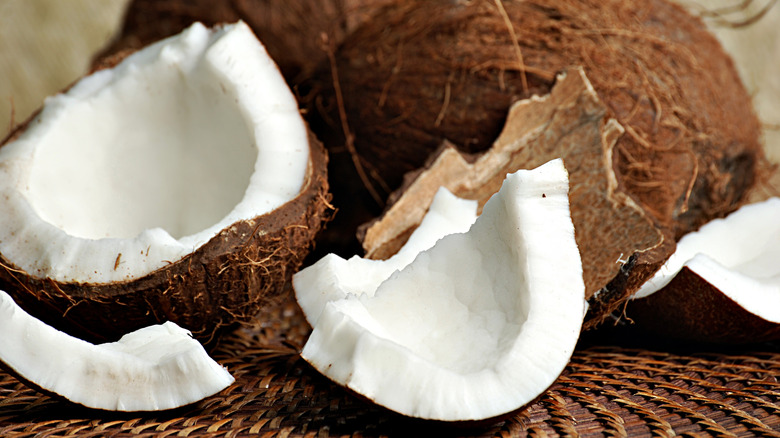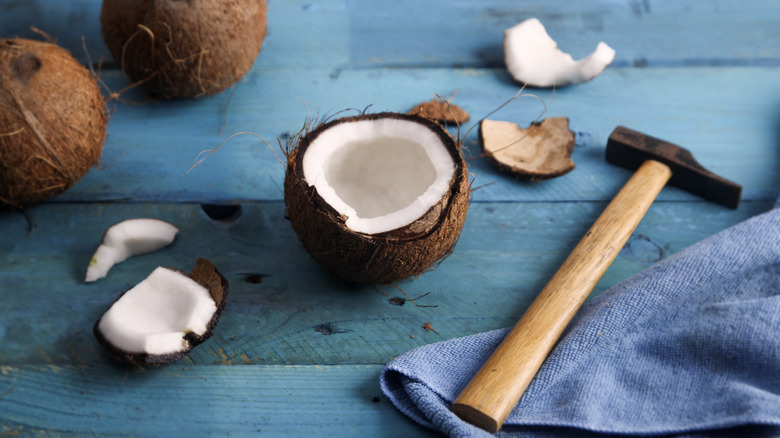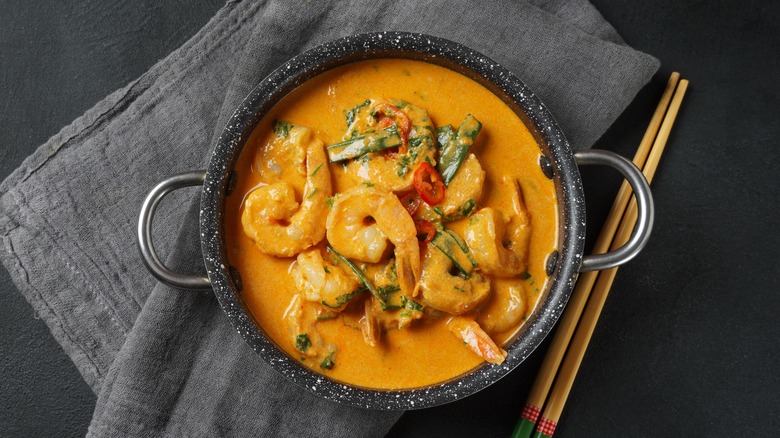How To Open A Coconut Without Hurting Yourself
Articles about food preparation techniques often open on a note of reassurance: "Sure, doing (insert technique here) might look like a challenge. But it's easier than you think!" The same is true of opening a coconut. That hard, hairy shell may seem imposing, but with the right tools and technique, you'll be handsomely rewarded for whatever effort you put in. That hard shell hides a multitude of riches: Not just refreshing, nutritious water, but rich flesh that can be eaten on its own or turned into coconut milk and coconut cream — just look to Thai cuisine to see the many, many sweet and savory uses for fresh coconut.
Still, most food prep techniques don't require the use of a screwdriver and a mallet, but this one does. Consider it a fun DIY project. There are actually no sharp knives involved here, only the correct implements and a little gentle pressure. This is for mature coconuts, by the way — the brown, hairy ones. With younger coconuts, which are often white-ish and sold wrapped in plastic, just a kitchen knife will do. Young coconuts are abundant in water, whereas older coconuts are a better source of coconut meat.
With mature coconuts, you'll first use that screwdriver to penetrate one of the "eyes," draining whatever water is stored within. Then, you'll use your tools to carefully crack the fruit open and scrape out the meat. Here's how.
Tips for cracking open a coconut
The first thing to do is locate the coconut's three eyes. Prodding with your screwdriver — you can also use a metal grilling skewer or some other sharp, pointy implement — find an eye that feels soft and push the sharp implement into it, tapping with the mallet if necessary. Once you've gotten through to the flesh, turn the coconut over into a measuring cup and drain out the coconut water. (You can then use that coconut water to make cocktails!)
To open the coconut itself, hold a folded kitchen towel in one hand and nestle the coconut in it. With the mallet in the other hand, tap around the widest part of the fruit, turning the coconut as you go. You should start to feel it crack open. If you want to speed up this process, prepare the coconut by heating it in the oven on a baking sheet for about 20 minutes at 400 degrees Fahrenheit, which will make the shell brittle. Alternatively, you can take the opposite approach and achieve similar results: Try sticking the coconut in the freezer for a couple of hours beforehand, as this will also make the shell easier to crack.
Once the coconut has cracked into pieces, put those pieces cut side down on a cutting board and tap the shell with the mallet to loosen the meat. Use a butter knife or a spoon to gently separate the flesh from the shell, then use a vegetable peeler to remove any remaining brown skin attached to the coconut meat.
What to do with your opened coconut
As anyone who's ever stored leftover coconut milk in the fridge for more than a couple of days can attest, coconuts don't have a particularly long shelf life — you only have up to four days to use the fresh meat from a mature coconut. That said, coconut meat freezes well. You can process it by, for instance, shredding the flesh in a food processor, then packing it into airtight containers or zipper bags and throwing it in the freezer for when you're ready to use it.
You might also be wondering what the deal is with some of the coconut byproducts you see in stores: coconut milk and coconut cream. Not much really separates them — both are made by combining water and grated fresh coconut. The difference is in the proportions. Coconut milk is made from approximately 2 parts coconut flesh to 1 part water, whereas coconut cream uses a 4:1 ratio, yielding a thicker, substantially richer liquid.
Both are used in sweet and savory preparations. Thai curries, for instance, might use either coconut milk or coconut cream, or both. Neither of these, though, should be confused with cream of coconut, which is coconut cream with added sugar. This means it's less ideal for curry. Cocktails and desserts, on the other hand ... can we interest you in a little Almond Joy ice cream?


